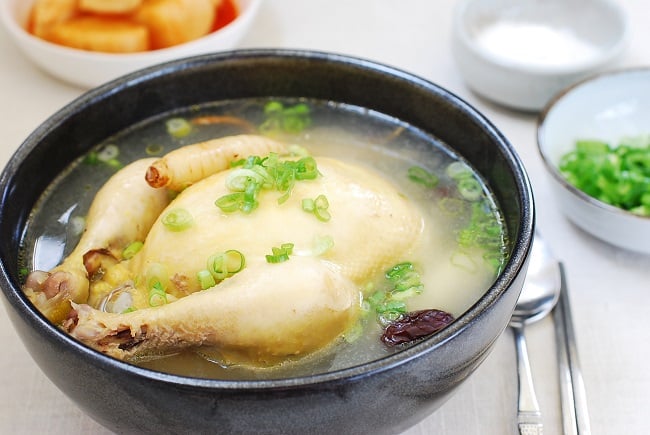Where did the summer go? I can’t believe it’s nearing the end. While it’s still here, here’s a recipe I’ve been wanting to share with you all summer long but just got around to complete. Samgyetang (삼계탕) is a chicken soup made with a small, whole chicken and ginseng. It’s an iconic summer dish in Korea. As strange as it sounds, we Koreans eat this boiling hot soup to beat the heat and stay energized during the summer. It’s especially popular on sambok days which are 3 distinct days based on the lunar calendar — chobok (beginning), jungbok (middle) and malbok (end) — that mark the hottest summer period. As the Korean saying goes, eating the hot soup is “fighting the heat with heat.” In my house, it’s a nourishing, comfort food which we enjoy all year around.
Sam refers to ginseng (insam, 인삼), gye is chicken, and tang is soup. Ginseng is highly prized for its medicinal benefits, including boosting energy and the immune system. I know some of you are wondering if you can make samgyetang without ginseng. You can omit the ginseng from this recipe and still make a tasty chicken soup, but, sorry – without ginseng, it can’t be called ginseng soup. When I don’t have ginseng, I make another type of chicken soup called dak gomtang. You can find fresh ginseng in Korean markets. I usually buy a package and freeze the leftovers. You can also use dried ginseng roots after soaking in the water for several hours to soften.
Samgyetang (Ginseng Chicken Soup)
AUGUST 24, 2014
Where did the summer go? I can’t believe it’s nearing the end. While it’s still here, here’s a recipe I’ve been wanting to share with you all summer long but just got around to complete. Samgyetang (삼계탕) is a chicken soup made with a small, whole chicken and ginseng. It’s an iconic summer dish in Korea. As strange as it sounds, we Koreans eat this boiling hot soup to beat the heat and stay energized during the summer. It’s especially popular on sambok days which are 3 distinct days based on the lunar calendar — chobok (beginning), jungbok (middle) and malbok (end) — that mark the hottest summer period. As the Korean saying goes, eating the hot soup is “fighting the heat with heat.” In my house, it’s a nourishing, comfort food which we enjoy all year around.
Sam refers to ginseng (insam, 인삼), gye is chicken, and tang is soup. Ginseng is highly prized for its medicinal benefits, including boosting energy and the immune system. I know some of you are wondering if you can make samgyetang without ginseng. You can omit the ginseng from this recipe and still make a tasty chicken soup, but, sorry – without ginseng, it can’t be called ginseng soup. When I don’t have ginseng, I make another type of chicken soup called dak gomtang. You can find fresh ginseng in Korean markets. I usually buy a package and freeze the leftovers. You can also use dried ginseng roots after soaking in the water for several hours to soften.
Traditionally, samgyetang is made with a young chicken, which is known as a Cornish hen in America, for its tender and tasty meat. If you need to feed more people, cook two small chickens in a larger pot rather than a large chicken.
The chicken is stuffed with soaked sweet rice (aka glutinous rice). Garlic, ginger, and jujubes (dried red dates) are other common ingredients. Jujubes are quite sweet, so do not use too many of them. Sometimes, other traditional herbs such as milk vetch roots (hwanggi, 황기) are added as well as chestnuts and ginkgo nuts. Some people stuff the chicken with ginseng, jujubes, etc., along with the rice, but I like to boil them in the broth to draw out the maximum flavors. Whatever you do, leave enough room in the cavity for the rice to expand in volume as it cooks, or the rice will be undercooked.
At restaurants, the whole chicken is served uncut as one serving, but it can easily be two servings. The soup is usually not seasoned while being cooked. It’s served with salt and pepper on the side, so each person can season the broth to taste and use the remainder to dip the meat in. The ginseng flavored meat is tasty and tender, and the broth is rich and delicious. Also, the sticky rice stuffing that’s infused with the chicken and ginseng flavors is to die for. If you’re trying it for the first time, samgyetang will be nothing like any other chicken soup you’ve had before.
1 to 2 servings
Ingredients:
1 cornish hen (about 1.5 pounds)
1 fresh ginseng root
3 tablespoons sweet rice, soaked for 1 hour (yields about 4 tablespoons soaked)
5 – 6 plump garlic cloves
1 thin ginger slice (about 1 inch)
2 to 3 jujubes (dried red dates)
1 scallion white part
5 to 6 cups of water
Ingredients:
1 cornish hen (about 1.5 pounds)
1 fresh ginseng root
3 tablespoons sweet rice, soaked for 1 hour (yields about 4 tablespoons soaked)
5 – 6 plump garlic cloves
1 thin ginger slice (about 1 inch)
2 to 3 jujubes (dried red dates)
1 scallion white part
5 to 6 cups of water
2 scallions, finely chopped, to garnish
salt and pepper to taste
salt and pepper to taste
Spoon off any visible fat. Serve piping hot with the chopped scallions and salt and pepper on the side so each person can season to taste.
